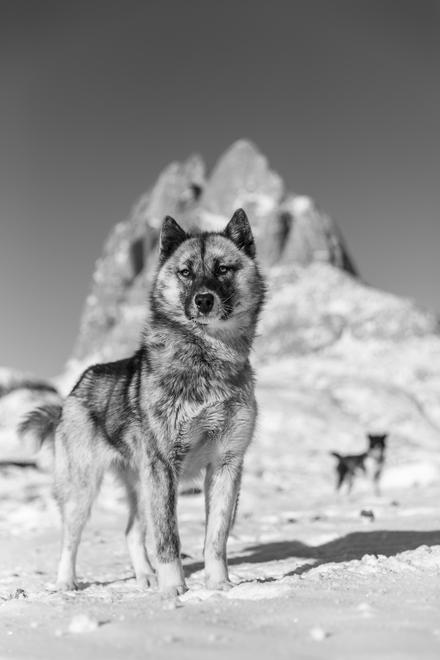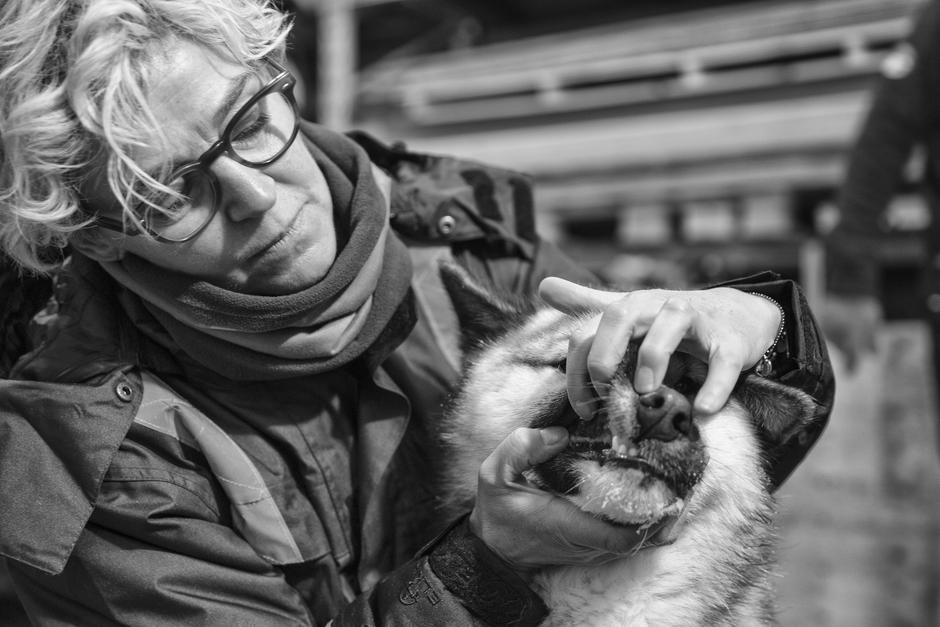
Milak (2016-2023), she sled dog with the characteristic Uummannaq mountain in the background. Uummannaq, March.

Veterinarian Rikke Langebæk examines a sled dog during QimmeqHealth. Ilulissat 2018.
These projects are affiliated with Ilisimatusarfik – the University of Greenland and the University of Copenhagen. The domestic dog in Greenland, particularly the Inuit sled dog, Nordic special breeds, and contemporary sheepherding and village dogs, continues to be a fascinating and crucial subject of study.
Qimmeq Project 2016-2022
Research from the Qimmeq Project encompassed the sled dog's genetic origins, health, and disease (including causes and prevention of outbreaks), as well as the profound intangible cultural significance of the sled dog. The research addressed three main questions:
- What is the origin of the Qimmeq and how do the regional populations of Qimmeq in Greenland relate to one another?
- What unique adaptations have strengthened the Qimmeq to survive in Arctic Greenland?
- What is the relationship between the dog, the Inuit, and the wolf in Greenland?
From 2016 to 2019, the project investigated the current sled dog culture and its genetic background, revealing an approximate 50% decline in the dog population over two decades. This critical finding underscored the urgent need for collaborative efforts to ensure a sustainable future for sled dogs in Greenland, generating significant research interest and uncovering valuable educational opportunities and societal benefits. The research deeply rooted in Greenland with a strong visual profile, effectively communicated its findings through a variety of channels, including scientific and popular articles, a traveling exhibition, five short films, a photo book, educational and children's books, and social media posts.
Qimmit 2023-2026
Building upon the Qimmeq project's insights into the genetic and recent cultural history of the Greenlandic sled dog, Qimmit (Greenlandic for "dogs" plural) aims to explore the broader history of Greenlandic dogs from 1000 AD to the present. This includes the dogs that accompanied the first Inuit across the Arctic tundra, those that arrived on Viking ships from Iceland, and contemporary sled dogs, sheepdogs, or pets.
Qimmit is a collaborative endeavor combining two distinct projects: "Dog as Cultural Icons – the History of Inuit and Norse Dogs in Greenland" (2023-2025), funded by the Augustinus Foundation, and "Ancient Thule Inuit dog populations in Southwest Greenland: proxy for future Inuit dog Survival in the Arctic" (2024-2026), funded by the Independent Research Foundation of Denmark. It represents a close collaboration among leading Greenlandic and Danish institutions: Globe Institute at the University of Copenhagen, the Greenland National Museum and Archives, Ilisimatusarfik, and the National Museum of Denmark.
The project employs an interdisciplinary approach to three key areas: the material culture of Inuit sled dogs, the historical context of Nordic dog breeds, and their connections to modern breeds in Southwest Greenland. By integrating archaeology, ethnography, genetics, and biology, Qimmit seeks a comprehensive understanding of these dogs and their enduring cultural significance.
The research addresses three main questions:
- What defines the material culture of the Inuit sled dog in Greenland and similar Arctic regions?
- What defines “Nordic” dogs, and how do they relate to each other and other contemporary breeds?
- Is there evidence of historical interbreeding between Nordic and Inuit sled dogs in Southwest Greenland?
QIMMEQ health
The primary veterinary goal of the Qimmeq Health project is to enhance the health and welfare of the culturally, genetically, and historically unique Greenlandic sled dog breed. This is achieved by increasing the availability of veterinary and medical services through temporary veterinary clinics in towns and settlements in Greenland. Concurrently, valuable research is conducted on sled dog health, diseases, and physiology. Given the Greenlandic sled dog's centuries-long presence in the Arctic, findings from these dogs can serve as crucial indicators for environmental processes, such as pollution by environmental toxins and zoonoses. Read more here.
Veterinary Care in the Sled Dog District
A significant challenge to sled dog health is the absence of practicing veterinarians, leaving owners without immediate veterinary assistance for injured or sick dogs. With funding from foundations like the Shipowner Per Henriksen and Wife Foundation and the Danish Society for Animal Welfare, Qimmeq Health continues to provide vital veterinary care through temporary clinics in various locations within North and east Greenland. These clinics strategically focus on areas with the highest number of registered sled dogs, including Ilulissat, Sisimiut, Uummannaq, Upernavik, and Tasiilaq, as well as smaller settlements when feasible.
Arctic Nomads
The Arctic Nomads project aims to raise awareness of dog sledding culture and its profound importance to Inuit people across the Arctic. As part of this initiative, an international sledding meeting was held in Sisimiut at the end of 2016, followed by a two-day seminar and lecture on dog sledding. The event brought together dog sled drivers from Russia, the USA, Canada, and Greenland, alongside politicians, tourist operators, researchers, and other key stakeholders. Based on the seminar, participants collaboratively developed proposals and recommendations for preserving and developing dog sledding culture for future generations.
Read more about research here:
Study on Ancient dog migrations into the North American Arctic.
Study on Approaching the Past through Practice: Reconstruction of a Historical Greenlandic Dog Sled.
Study on Dog sledding in the archaeological record.
Study on Encounters between Greenlandic sled dogs, humans, and Arctic wolves in West and North Greenland.
Study on Greenland Hunters Bred Sled Dogs With Wolves for Strength
Study on How hunters in North Greenland bred sled dogs with wolves for aggression, fearlessness, and strength
Study on Human-Dog Symbiosis and Ecological Dynamics in the Arctic
Study on Interbreeding of Greenlandic sled dogs and Arctic wolves in Avanersuaq, North Greenland.
Study on nanorriutit—polar bear hunting dogs in Avanersuaq.
Study on Of skin and bones: re-visiting an Inughuit dog sled procured by John Ross in 1818.
Study on Origins and diversity of Greenland’s Qimmit revealed with genomes of ancient and modern sled dogs
Study on The discovery of an ancient Siberian dog and the unique adaptations of the Greenlandic sled dog.
Research in the global news
Study on dog Breeding in the Neolithic Age
Study on Wolves at the door: How Arctic predators’ recovery is reshaping life in Greenland